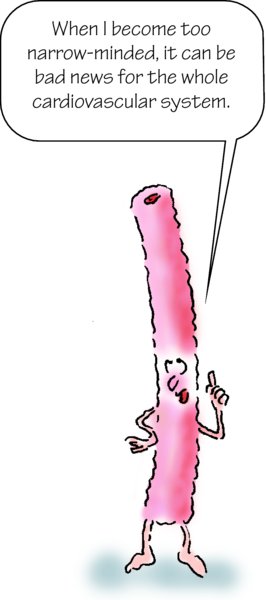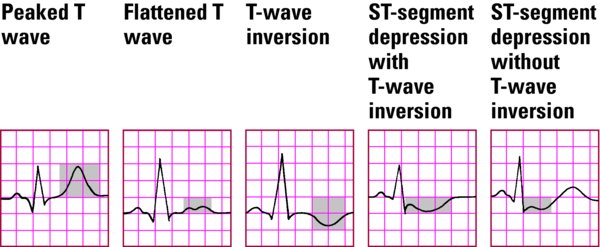- A symptom of myocardial ischemia
- Occurs when the myocardium needs more oxygen than the coronary arteries can deliver
Stable Angina
- Provoked by exertion or stress
- Usually lasts 2 to 10 minutes
- Typically relieved by rest
- Repeats in this pattern
Unstable Angina
- Provoked more easily than stable angina
- Commonly wakes the patient
- Unpredictable
- Worsens over time
- Classified as an acute coronary syndrome with MI
- Treated as a medical emergency
- Usually signals an MI
| ||||||||||||
Prinzmetal Angina
- A relatively uncommon form of unstable angina
- Usually occurs at rest or wakes the patient from sleep
What causes it
- Decreased blood flow results from narrowing of the arteries from coronary artery disease (CAD), which may be complicated by platelet clumping, thrombus formation, or vasospasm.
- In Prinzmetal angina, vasospasm results from a focal episodic spasm of a coronary artery, with or without an obstructing coronary artery lesion.

What to look for
Stable Angina
- Predictable pain pattern
- Substernal or precordial burning, squeezing, or tightness
- May radiate to left arm, neck, or jaw
- Relieved by nitrates or rest
Unstable Angina
- Chest pain that may radiate
- Greater intensity and duration than stable angina
- Also pallor, diaphoresis, nausea, or anxiety
Prinzmetal Angina
- Substernal chest pain from heaviness to crushing discomfort
- Usually occurs at rest or wakes the patient from sleep
- Also dyspnea, nausea, vomiting, or diaphoresis
How It's Treated
- Give nitrates to reduce myocardial oxygen consumption.
- Give beta-adrenergic blockers to reduce the heart's workload and oxygen demands.
- Give calcium channel blockers to treat angina caused by coronary artery spasm.
- Give antiplatelet drugs to minimize platelet aggregation and the risk of coronary occlusion.
- Give antilipemic drugs to reduce elevated serum cholesterol or triglyceride levels.
- Anticipate coronary artery bypass surgery (CABG) or percutaneous transluminal coronary angioplasty (PTCA) for obstructive lesions.

